Systematic position, Diagnostic and General characters, Botanical description, Floral Formula, Economic Importance - Family: Fabaceae (Pea family) | 11th Botany : Chapter 5 : Taxonomy and Systematic Botany
Chapter: 11th Botany : Chapter 5 : Taxonomy and Systematic Botany
Family: Fabaceae (Pea family)
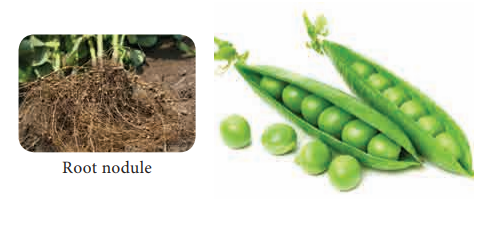
Dicot Families
Plant kingdom is so vast and varied. For the purpose of study, they have been classified into Artificial, Natural, Phylogenetic and APG system in course of time. Bentham and Hooker system of classification is followed in India till recently. Great variation occurs not only in different families, but also varies in genera and species which are included within the family. Variation occurs in number, arrangement, adhesion and cohesion.
Family: Fabaceae (Pea family)
Systematic position

Diagnostic features
• Leaves simple or imparipinnately compound or palmate, leaf base pulvinate, leaflets stipellate.
• Flowers Zygomorphic
• Corolla: Papilionaceous, descendingly imbricate aestivation, posterior petal outermost,
• Petals clawed.
• Stamens: Monadelphous, diadelphous
• Ovary stipitate (a short stalk as the base), monocarpellary, unilocular with marginal placentation.
• Fruit a legume or lomentum.
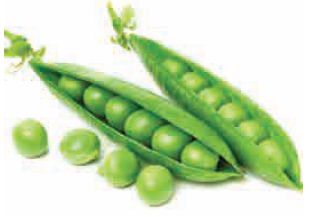

General characters
Distribution: Fabaceae includes about 741 genera and more than 20,200 species. The members are cosmopolitan in distribution but abundant in tropical and subtropical regions.
Habit: All types of habits are represented in this family. Mostly herbs
(Indigofera, Crotalaria), prostrate (Indigofera enneaphylla) erect (Crotalaria verrucosa), shrubs (Cajanus cajan), small trees (Sesbania), climbers (Clitoria), large tree (Pongamia, Dalbergia, Erythrina, Butea), woody climber (Mucuna), hydrophyte (Aeschynomene aspera) commonly called pith plant.
Root: Tap root system, roots are nodulated , have tubercles containing Root nodule nitrogen – fixing bacteria (Rhizobium leguminosarum).
Stem: Aerial, herbaceous, woody (Dalbergia) twining or climbing Clitoria.
Leaf: Leaf simple or unifoliate (Desmodium gangeticum) bifoliate (Zornia diphylla,), Trifoliate (Lablab purpureus), unipinnate or simple pinnate (Clitoria), alternate, stipulate, leaf base, pulvinate, stipulus 2, free. Leaves showing reticulate venation terminal leaflet modifies into a tendril in Pisum sativum.
Inflorescence: Raceme (Crotalaria verrucosa), panicle (Dalbergia latifolia) axillary solitary (Clitoria ternatea)
Flowers: Bracteate, bracteolate (Sesbania), pedicellete, complete, bisexual, pentamerous, heterochlamydeous, zygomorphic hypogynous or sometimes perigynous.
Calyx: Sepals 5, green, synsepalous, more or less united in a tube and persistant, valvate or imbricate, odd sepal is anterior in position.
Corolla: Petals 5, apopetalous, unequal and papilionaceous, vexillary or descendingly imbricate aestivation all petals have claw at the base. The outer most petal is large called standard petal or vexillum, Lateral 2 petals are lanceolate and curved. They are calledwing petals or alae. Anterior two petals are partly fused and are called keel petals or carina which encloses the stamens and pistil.
Androecium: Stamens10,diadelphous, usually 9+1 (Clitoria ternatea). The odd stamen is posterior in position. In Aeschynomene aspera, the stamens are fused to form two bundles each containing five stamens (5)+5. Stamens are monadelphous and dimorphicie. 5 stamens have longer filaments and other 5 stamens have shorter filaments thus the stamens are found at two levels and the shape of anthers also varies in (Crotalaria verrucosa). (5 anthers are long and lanceolate, and the other 5 anthers are short and blunt). Anthers are dithecous, basifixed and dehiscing longitudinally.
Gynoecium: Monocarpellary, unilocular, ovary superior, with two alternating rows of ovules on marginal placentation. Style simple and bent, stigma flattened or feathery.
Fruit: The characteristic fruit of Fabaceae is a legume ( Pisum sativum), sometimes indehiscent and rarely a lomentum (Desmodium).
In Arachis hypogea the fruit is geocarpic (fruits develops and matures from underground). After fertilization the stipe of the ovary becomes meristematic and grows down into the soil. This ovary gets buried into the soil and develops into fruit.
Seed: Endospermic or non-endospermic (Pisum sativum), mostly reniformed.
Botanical description of Clitoria ternatea (Sangu pushpam)
Habit: Twining climber
Root: Branched tap root system having nodules.
Stem: Aerial, weak stem and a twiner
Leaf: Imparipinnately compound, alternate, stipulate showing reticulate venation. Leaflets are stipellate. Petiolate and stipels are pulvinated.
Inflorescence: Solitary and axillary
Flower: Bracteate, bracteolate, bracteoles usuallylarge,pedicellate,heterochlamydeous, complete, bisexual, pentamerous, zygomor-phic and hypogynous.
Calyx: Sepals 5, synsepalous, green showing valvate aestivation. Odd sepal is anterior in position.
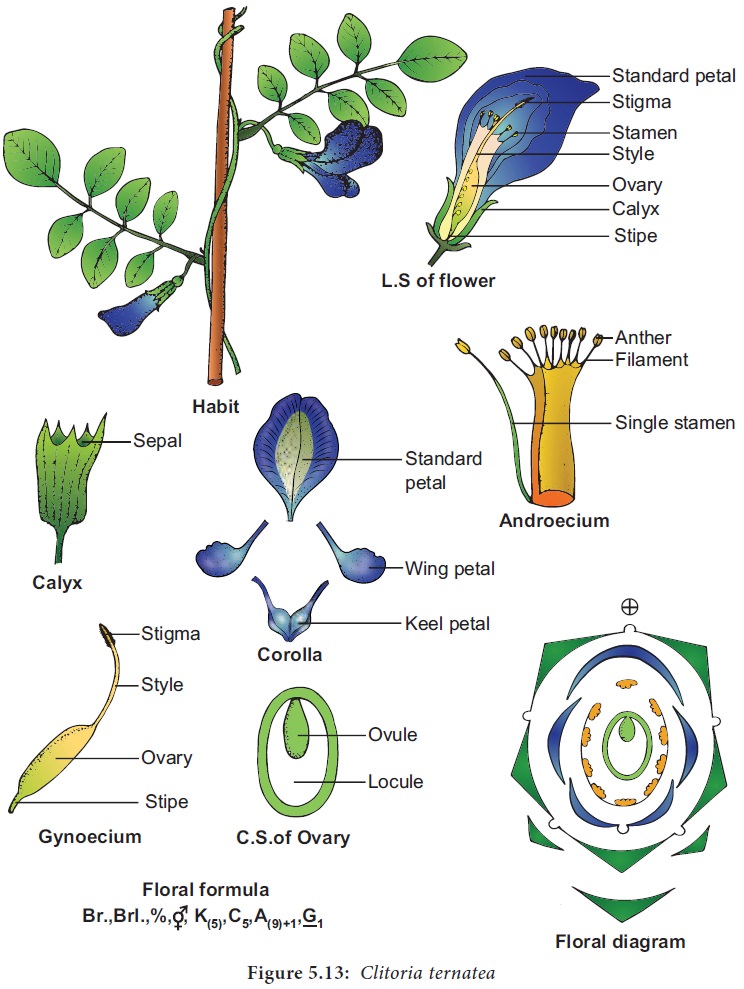
Corolla: Petals 5, white or blue apopetalous, irregular papilionaceous corolla showing descendingly imbricate aestivation.
Androecium: Stamens 10, diadelphous (9)+1 nine stamens fused to form a bundle and the tenth stamen is free. Anthers are dithecous, basifixed, introse and dechiscing by longitudinal slits.
Gynoecium: Monocarpellary, uni-locular, with many ovules on mariginal Âplacentation, ovary superior, style simple and incurved with feathery stigma.
Fruit: Legume
Seed: Non-endospermous, reniform.

Botanical description of Pisum sativum (Pea Plant)
Habit: Cultivated herb, becoming shrubby.
Root: Branched tap root system, nodulated due to the presence of nitrogen fixing bacteria (Rhizobium leguminosorum).
Stem: Erect and climbing, one to three feet high, young stem densely pubescent, somewhat angular, herbaceous, green and branched.
Leaves: Alternate, petiolate, stipulate, stipules ¼ to ½ inch long attached near the base, compound (trifoliate), leaflets dark green, entire, acuminate, pubescent on both the sides, reticulate venation.
Inflorescence: Clustered axillary racemes.
Flower: Bracteate (small and deciduous), bracteolate (usually persistent), pedicellate, heterochlamydeous, complete, bisexual, pentamerous, zygomorphic and hypogynous.
Calyx: Sepals 5, green synsepalous, companulate, showing valvate aestivation. Odd sepal is anterior in position.
Corolla: Petals 5, apopetalous, irregular papillionaceous, consisting of a posterior standard, two lateral wings, two anterior ones forming a keel which encloses stamen and pistil, vexillary / descendingly imbricate aestivation.
![]()
![]()
![]()
Androecium: Stamens 10, diadelphous (9)+1 nine stamens fused to form a bundle and the tenth one is posterior and free. Anthers dithecous, basifixed, introse and dehisce longitudinally.
Gynoecium: Monocarpellary, ovary superior, unilocular, with many ovules on marginal placentation, style simple and curved, stigma capitate.
Fruit: Legume
Seed: non-endospermous with thick cotyledons.

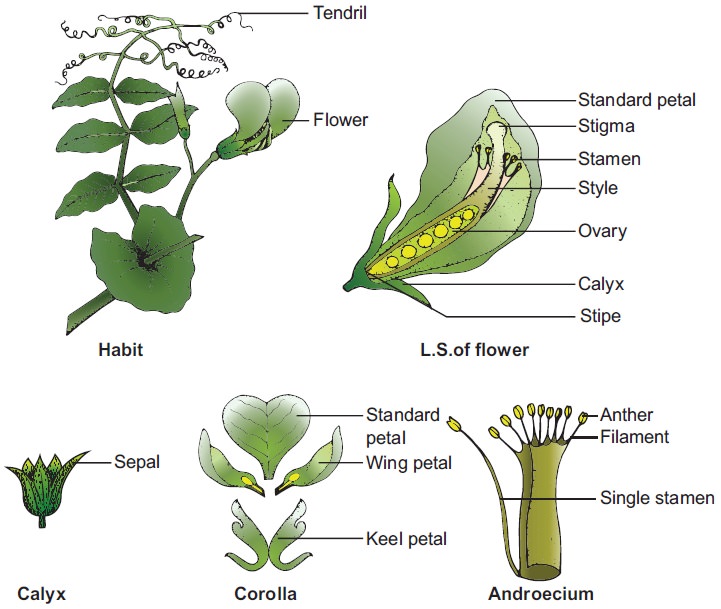
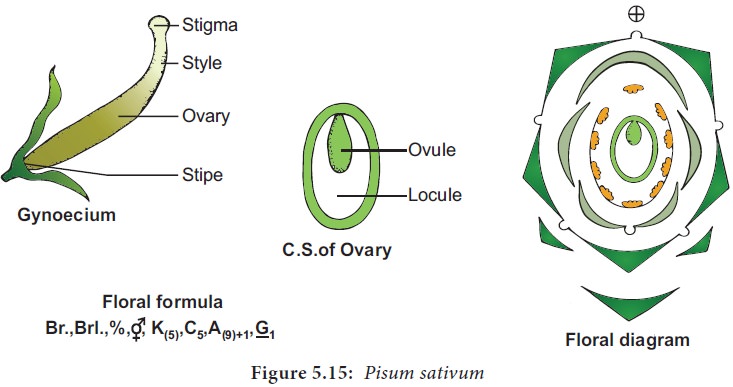
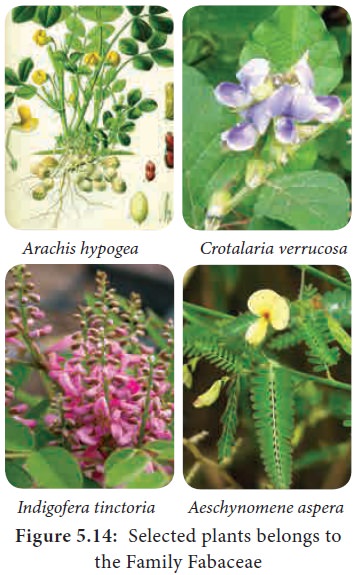
Economic Importance
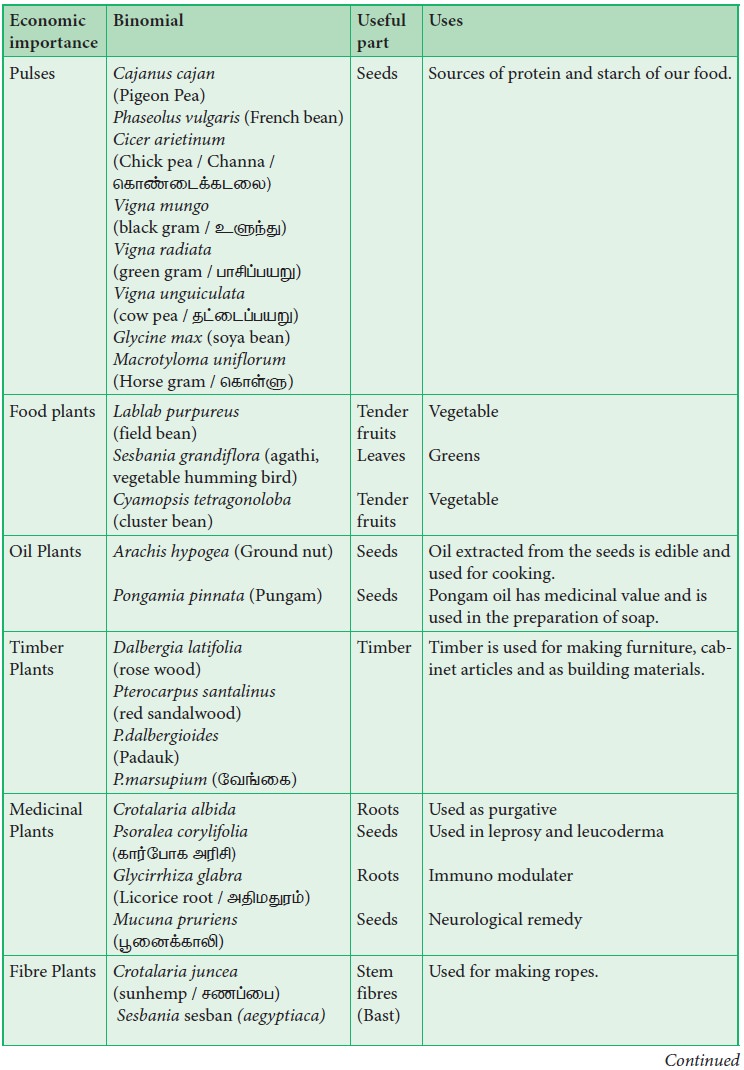
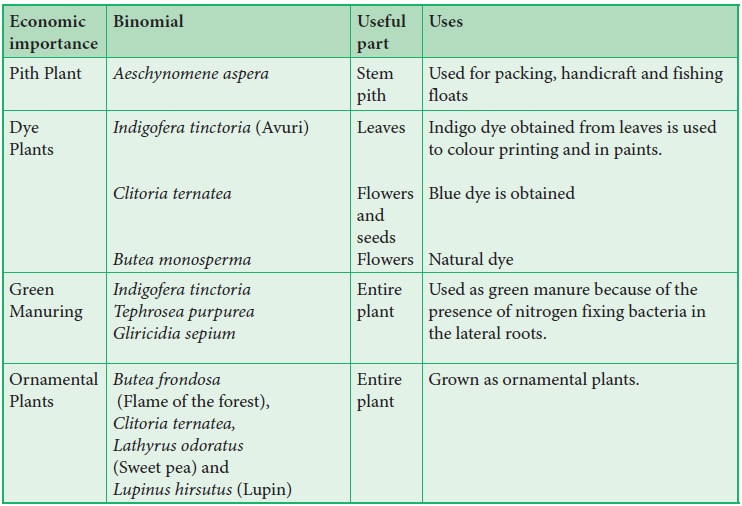
Related Topics